

Nunnery in Corso Cavour (ca. 1490)
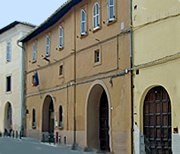
The Blessed Colomba established a small community of Dominican tertiaries here after she took vows at the nearby church of San Domenico in 1490. This community began to attract noble women, and she decided to establish a nunnery dedicated to St Catherine of Siena. It received substantial subsidies from the Dieci dell' Arbitri in the period 1492-4. The Blessed Colomba laid the foundation stone of a new dormitory and refectory for the growing community in 1493, by which time the construction of an oratory for the nuns was already underway. Funds were probably also raised when the intercession of the Blessed Colomba was thought to have mitigated the effects of plague in the city in 1494. The Blessed Colomba died here in 150, and the nuns subsequently changed the dedication their nunnery in her honour.
In 1566, Pope Pius V issued the bull Circa Pastoralis, which decreed that tertiary nuns other non-cloistered female communities should take solemn vows and adopt clausura. The nuns tried to resist, not ;east because this would bar them from the charitable work that they had traditionally undertaken in their neighbourhood. However, following an apostolic visitation, Monsignor Paolo Maria della Rovere, Bishop of Cagli in 1571,they were forced to accede.
A group of nuns that had moved to the church of Santa Maria Colombata in 1528 was sent back to their mother house in 1575, probably because of their bad behaviour.
The complex was restored in ca. 1760 and Bishop Francesco Riccardo Ferniani consecrated it in 1761.
The nunnery was suppressed in 1864, when some of the nuns moved to a house in what is now Via Imbriani while others moved to join those who had been allowed to remain at the Monastero di San Tommaso. They moved to a new nunnery in Corso Garibaldi (see below) in 1940.
Their original nunnery was converted into a barracks and now houses the Fire Brigade. Its church survives inside, but now houses fire engines and cannot be visited.
Frescoes (ca. 1761)
These frescoes in the vaults of the newly restored church are by Francesco Appiani and Paolo Brizi.
Nunnery in Corso Garibaldi (13th century)
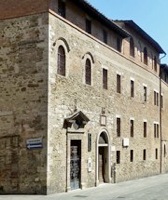
This ancient building has had a varied history:
-
✴The inscription in its façade records the tradition that SS Francis and Dominic met here in 1220.
-
✴The inscription above the portal records that it later housed the Conservatorio della Carità (1562), which provided an education for poor young women.
-
✴The nuns from the original Monastero della Beata Colomba who had moved to Via Imbriani and those concentrated at the Monastero di San Tommaso (see above) moved here in 1940.
The relief of a dove above it is the symbol of the Blessed Colomba. The small niche to the left was for the collection of alms. The bronze relief of the Blessed Colomba above it was commissioned in 1967, on the 500th anniversary of here birth.
The church is open for services, and the sisters welcome visitors at other times (ring the bell on the right). The portal opens into an entrance hall, with:
-
✴the church on the left; and
-
✴the Cappella di Beata Colomba on the right.
Church
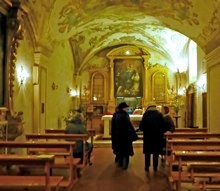
The church is in the form of a single, vaulted nave.
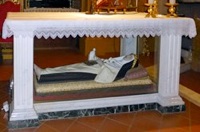
The [relics?] of the Blessed Colomba are under the altar.
Madonna della Rosario (17th or 18th century)
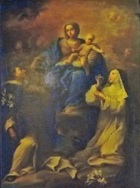
Incredulity of St Thomas (copy - 1881)
The original altarpiece, which is attributed to Giannicola di Paolo and dated on stylistic grounds to the 1530s, was painted for the nuns of the Monastero di San Tommaso. It was on the high altar of the church until 1879, when it moved to the Galleria Nazionale. It depicts the risen Christ standing in a landscape while St Thomas examines the wound in His side and St John the Evangelist records the scene for his gospel. To the right, SS George, Benedict and Antony Abbot look on. The figures of SS Dominic and Antony Aquinas to the left were added later, almost certainly after 1555, when the nuns were transferred from the Cistercian to the Dominican Order: they possibly replaced an original figure of St Bernard of Clairvaux, the Cistercian founder.

Cappella di Beata Colomba
The chapel is a replica of Beata Colomba’s original cell in Corso Cavour and houses her bed and some of her other personal possessions. A relic of her cranium is preserved under the chapel’s altar.
Christ Carrying the Cross (ca. 1497)
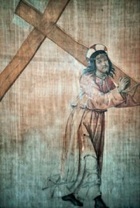
This panel is apparently documented as in existence in September 1497. It is usually attributed to the young Giovanni di Pietro, lo Spagna, but its poor state of conservation make this uncertain. If he did indeed paint it before the documented date, it is his earliest known work.
Return to Nunneries of Perugia.
Return to Monuments of Perugia.
Return to Walk IV (for the nunnery in Corso Cavour); or
Walk V (for the nunnery in Corso Garibaldi).

